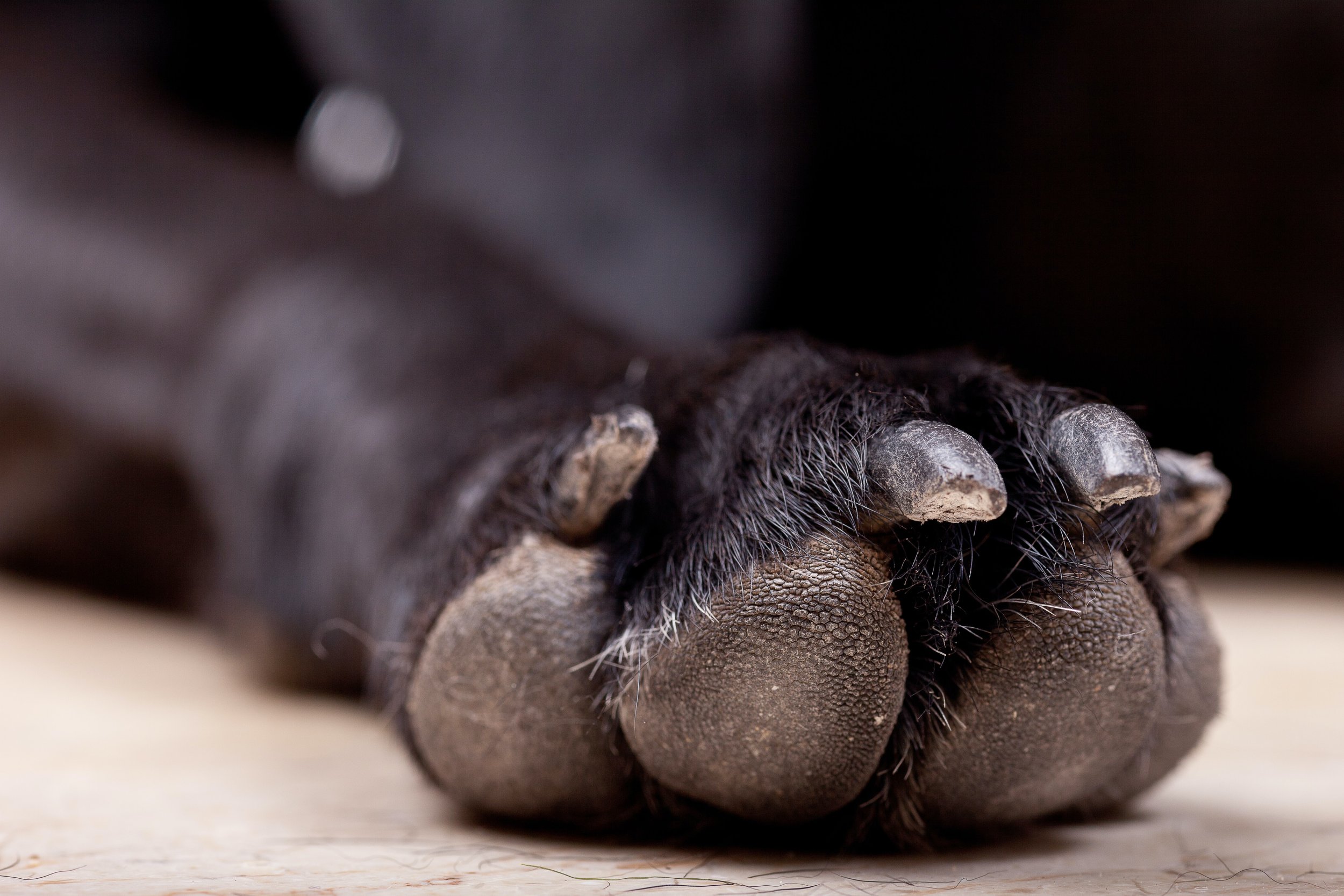How to Clip Your Dog's Nails Without the Drama
The Dreaded Nail Cutting, What Even Is It?
Some of us may know what it’s like for your dog to be running away from you as you chase them around the living room with nail clippers. Or maybe you recall trying to get them to hold still while they whimper - is that an all too-familiar feeling? Knowing how to get your dog comfortable with clipping, which clipper is the best, and how to trim their nails can make for all together more pleasant experience for everyone - not to mention prevent any potential injuries.
Why Do I Have to Trim My Dog’s Nails?
Just like humans, dog’s nails seem some maintenance. And, since they can’t do it themselves, it’s up to the owner to take on the daunting challenge (but we promise it doesn’t have to be daunting!).
Dogs need their nails trimmed because it can be quite painful when they get too long. Nails that are too long can dig back into their paws when they step on the ground, curl back into their paw, or break off too short and start bleeding. To have an idea of the best time to trim their nails, try cutting them right before they are long enough to hit the ground. A good rule of thumb is about once a month, but if your dog walks or runs a lot on pavement than you might be able to wait a little longer since the nails are sanded down naturally. If your dog is more of an indoor dog, then a month is a safe bet.
How Do you Safely Trim Your Dog’s Nails? It’s Just Like Us, Right?
Unlike human’s nails, dogs actually have a vein in their nails called the “quick.” The quick contains a blood vessel and nerves that run through your dogs nails, so you can image it can be quite painful if it gets nipped. In order to not hit the quick, you have to be very careful. If you’re lucky, your dog will have white nails. While this isn’t always the case, if it is, you can see where the quick actually is. It will be an opaque pink color under the nail which makes it a lot easier to see what you’re doing. If your dog has black nails, your job is a little trickier. You have to go very slowly and little by little until you see the pulp. The pulp sits right in front of the quick and it looks black. So, keep trimming the nail until the white turns black. With this knowledge, you should be good to give it a safe try.
QUICK TIP : Even though you’re going to try your best, accidents happen- trimming your dog’s nails isn’t easy. It’s good to have a blood clotting powder nearby to stop any bleeding if you accidentally go a little too short. Check out this one, it even has some pain reliever in it.
Why Is My Dog Petrified of the Nail Clippers?
If they had a negative experience in the past, like someone trimming their nails too short and exposing the quick (which can happen very easily) or being restrained too forcefully, they can associate the activity with pain. If this happens, or if your dog is just nervous in general, check out the tips we have below.
Two Methods to Get Rid of the Shakes
If your dog is a little more nervous, try desensitizing them or switching to a different kind of clipper.
Desensitizing Your Dog to The Nail Clippers
Desensitizing means taking away the negative association with the clippers and replacing it with a neutral reaction. This takes away any fear and makes the whole process a lot smoother.
In order to do this, it is very important for your dog to see you aren’t nervous (because there is nothing to be nervous about!). You want to approach the situation as if the nail clippers are like any other object. Grab the clippers and their favorite treats and put on a smile. Set the clippers down in front of the dog and when they look at the clippers, give them a treat. If they are too nervous or back away, move the clippers further away from them. It’s important to not force them into anything. If this stage works, then move on to touching the dogs with the closed clippers and giving them a treat. Make your way to the clippers touching their paws and if they are still okay, you should be good to go. Remember to work slowly and only do this for a couple minutes a day so you don’t overwhelm them. By the end of this process, they should no longer fear the clippers.
QUICK TIP: Don’t act too excited because you don’t want your dog to associate clipping their nails with lots of energy or it might be hard to get them to hold still while you do it in the future.
Different Kinds of Nail Trimmers
If you are still having trouble, it could be the kind of clippers. There are mainly three types: the scissor style, the guillotine style (not as scary as it sounds), and the nail grinder (also not as scary as it sounds). Choosing the right kind can make your job easier and make your dog more comfortable.
Scissor Style
Scissor style nail clippers looks exactly like the name suggests, a pair of scissors. They operate by your force of hand and you clip your dog’s nails as you would cut a piece of paper. These can give you more control and work great if your dog is calmer, but they can be harder if your dog is squirmy. Since these require more precision, your dog needs to be pretty still. There are smaller and larger sizes depending on your dog. Click here for one we recommend.
Guillotine Style
Your mind might be going to mid-century torture right now, but we assure you it’s nothing gruesome! This clipper works by placing the nail in the opening and pressing down as it cuts the nail off. The benefits of this style is that it is easier to control than the scissors, so it might be a better alternative for the pups who are more stressed out. A con is with this style, you might get more blunt ends that, while fine for the dog, might scratch you if they jump up to give you a hug. Here is a fan favorite of this style.
QUICK TIP: If your dog has more brittle nails, try cutting them after giving them a bath so their nails are more wet and less likely to break off in unwanted ways. This can be applied for any type of clipper.
Nail-Grinder
The nail grinder is a little different from the other two because it doesn’t have a blade. This one works as a drill that sands down your pup’s nails gradually. It has its pros and cons like the others. The vibration and noise may be uncomfortable or unwanted by the dog and may take more getting used to. It is also the most time consuming style. But, the bonus is that this is the safest option. You can go slowly and carefully and are far less likely to hit the quick. And, it can give a smoother finish. If you’re interested, try this one!
Clip Away!
Now that you have some tricks up your sleeve, we hope that you and your dog have a safe and pleasant nail clipping experience, one without the crying (we mean by the dog…or both you and your dog!). Knowing when to cut their nails, how short to cut them, how to make them less nervous, and picking out the right type will surely eliminate the concerns.
Sources-
https://www.dailypaws.com/dogs-puppies/health-care/dog-first-aid-emergency/how-to-stop-a-dogs-nail-from-bleeding
https://healthyhomemadedogtreats.com/how-to-find-the-quick-on-black-dog-nails/
https://www.akc.org/expert-advice/health/how-to-trim-dogs-nails-safely/#:~:text=Clip%20only%20the%20tip%20of,is%20painful%20and%20will%20bleed.
https://www.caninetofive.com/the-at-home-guide-to-trimming-your-dogs-nails/
https://be.chewy.com/guide-trimming-dogs-nails/
https://www.hepper.com/different-types-of-dog-nail-clippers/
https://www.dailypaws.com/gear-apparel/dog-supplies/dog-grooming-supplies/best-dog-nail-clippers
This blog was written by Samantha Dailey, the Social Media Associate at Dog Tired Adventures. Sam loves to hike around the hills, find new recipes, and to hangout with her Shih-Tzu Maltese she’s had since she was a kid.




